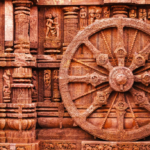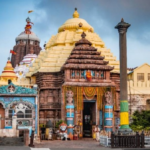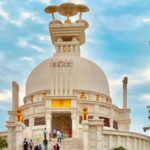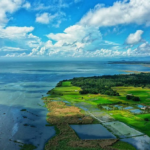Of the 58 known mangrove species in India, 55 are found in the Bhitarkanika Mangroves. The world’s most significant olive ridley sea turtle nesting site is Gahirmatha site, which divides the mangroves from the Bay of Bengal. The mangroves are home to one of India’s greatest populations of saltwater crocodiles. Based on the skull saved by the Kanika Royal Family, some wildlife specialists believe that the largest saltwater crocodile ever measured 23 feet (7.0 m) and was found in Bhitarkanika.The crocodile was shot in 1926 close to Dhamara, and the Kanika King at the time treasured its skull. Crocodile specialists calculate that the animal’s length ranged from 20 feet (6.1 m) to 23 feet (7.0 m), with the skull’s size accounting for one-ninth of the body’s overall length. The Guinness Book of World Records acknowledged the park in 2006 as the home of the largest captive-bred white crocodile, measuring 23 feet. A sizable and varied population of both permanent and migratory birds can be found in the wetland. The following animals can be found in the wild: striped hyena, mole rat, long-tailed tree mouse, jackal, common mongoose, leopard cat, fishing cat, jungle cat, small Indian civet cat, toddy cat, Indian fox, wild pig, and Indian porcupine.
OLIVE RIDLEY TURTLES
Tourists enjoy a plethora of activities at the world’s largest olive ridley turtle nesting beach, the Gahirmatha coast in the Kendrapara district. Gahirmatha, an important site for turtle conservation, was designated as a world heritage site in 1979 and a wild life sanctuary in Odisha. Travelers who love the outdoors are drawn to the sanctuary by its magnificent scenery, which is situated where the Dhamra River and the Bay of Bengal converge. You will be astounded by how large the sanctuary is—nearly 1,435 km2. The sanctuary has gradually gained recognition as a significant location for Odisha tourism since it was designated as a World Heritage Site. Gahirmatha Turtle Sanctuary is home to a diverse range of plants and animals.In the sanctuary, one can find a wide variety of plants, including bels, terminenalia, zizphus bija, salaia sal, babul, teak, and bamboo. The sanctuary is home to a variety of wildlife, including wild boars, barking deers, bears, leopards, crocodiles, jungle fowl, hyenas, wild dogs, four-horned antelopes, sloth bears, and blue bulls. However, it is most well-known for its enormous olive ridleys, which come as far as the Pacific Ocean to nest there. Thousands of turtles can be seen dragging themselves towards the beach under a clear lunar night during the nesting season, as they puff and struggle their way out of the water.Within 45 minutes, they typically choose a good location, use their flippers to dig a hole in the sand, deposit about 120 eggs apiece, cover and compact the holes with their bodies, remove any signs of their visit, and crawl back to the sea. Environmentalists believe that this is one of the wonders of nature. This secure environment for giant turtles has been established by the state government with help from local and international NGOs. This has only been made feasible by abiding by stringent laws that outlaw fishing and prevent adjacent industries from operating out of control. Today, the government’s prompt intervention has allowed the innocent creatures to at least walk around freely. In Gahirmatha, thousands of enormous olive ridleys.the marine sanctuary, keep an eye out for equally amazing animals that are flourishing elsewhere. Conveniently located, the early 9th-century Lord Shiva temple at Dangmol is a worthwhile visit. A popular destination is the national park and wild life sanctuary Bhitarkanika, which is close to the Gahirmatha sanctuary. With a lands area of 672 km2, it is regarded as the second largest mangrove environment in India. Over 2145 different species of birds find refuge in the forest. It is also known as a “crocodile sanctuary” and is the largest saltwater crocodile population in the nation.
Before the Odisha government dissolved the zamindari system and gave the state forest department authority over the zamindari forests in 1952, the Bhitarkanika Mangroves were zamindari forests. A 672 km2 area was designated as the Bhitarkanika Wildlife Sanctuary in 1975. In September 1998, the 145 km2 central region of the sanctuary was designated as Bhitarkanika National Park. Established in September 1997, the Gahirmatha Marine Wildlife Sanctuary includes Gahirmatha Beach and a nearby section of the Bay of Bengal. It borders the Bhitarkanika Wildlife Sanctuary to the east. The Ramsar Wetland of International Importance designation was given to the Bhitarkanika Mangroves in 2002.
FEW IMPORTANT AND INTERESTING FACTS ABOUT THE PLACE
- It is the second-largest mangrove ecosystem in India.
- Winter months are the best time to visit the place.
- It is around 130km from the state-capital, Bhubaneshwar.
















